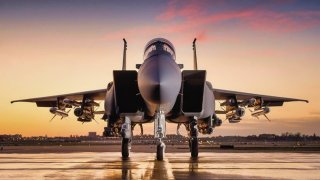F-15SA: Saudi Arabia Has a Very Special and Expensive F-15 Fighter
The F-15SA is the most advanced version of the upgraded two-seat F-15S Strike Eagle, and is currently operated by the Royal Saudi Air Force's No. 3 Wing at King Abdulaziz Air Base, No. 92 Squadron RSAF; and No. 5 Wing at King Khalid Air Base, No. 6 Squadron RASF and No. 55 Squadron RSAF.
Earlier this month, a Saudi Royal Air Force F-15SA fighter jet crashed, killing its two crew members on board, the kingdom confirmed. The crash occurred during a training mission at King Abdulaziz Air Base in Dhahran in the eastern portion of the Middle Eastern nation.
This latest incident followed another crash of the Saudi Arabian variant of the McDonnell Douglas F-15E Strike Eagle in July. That mishap occurred near the King Khalid Air Base in Khamis Mushait, during which its two pilots were also killed.
It has been reported that Prince Talal Bin Abdulaziz was one of the two pilots killed in the recent crash.
The Saudi Strike Eagle
The F-15SA is the most advanced version of the upgraded two-seat F-15S Strike Eagle, and is currently operated by the Royal Saudi Air Force's No. 3 Wing at King Abdulaziz Air Base, No. 92 Squadron RSAF; and No. 5 Wing at King Khalid Air Base, No. 6 Squadron RASF and No. 55 Squadron RSAF.
It is an advanced version of the Strike Eagle, and it was developed to incorporate features from, and even build on South Korea's F-15K Slam Eagle, Singapore's F-15SG, and the F-15SE Silent Eagle. The F-15SA is equipped with a number of enhanced systems and structural improvements compared to the basic F-15S used by the RSAF.
The fourth-generation fighter is powered by two GE Aviation F110-GE-129 afterburning turbofans, the F-15SA employs a fly-by-wire flight control system – which allows for the reactivation of additional underwing pylons stations one and nine – as well as advanced cockpit displays and Raytheon's AN/APG-63(V)3 active electronically scanned array (AESA) radar
The aircraft further features a structurally redesigned wing and a new nose barrel.
The F-15SA is equipped with BAE Systems-developed digital electronic warfare system/common missile warning system (DEWS/CMWS); Lockheed Martin's AN/AAS-42 infrared search and track (IRST) system; a Joint Helmet Mounted Cueing System (JHMCS) and a Link-16 multifunctional information distribution system (MIDS). The platform can be equipped with Lockheed Martin’s AN/AAQ-33 Sniper advanced targeting pod (ATP), as well as the firm’s AN/AAQ-13 Low Altitude Navigation and Targeting Infrared for Night (LANTIRN) system.
The F-15SA can employ a range of weapons and can be configured for both air-to-air and air-to-surface operations. In an aerial combat role, the F-15SA can be armed with the AIM-9X Sidewinder short-range air-to-air missile and the AIM-120C-7 Advanced Medium-Range Air-to-Air Missile (AMRAAM). The multi-role fighter is also fitted with a single M61 Vulcan 20mm cannon.
For air-to-surface engagements, the aircraft can carry the AGM-84H/K Stand-off Land Attack Missile-Expanded Response (SLAM-ER) precision-guided, air-launched cruise missile. In addition, it can be armed with the AGM-88 High-speed Anti-Radiation Missile (HARM); GBU-24 Paveway III laser-guided bomb and Joint Direct Attack Munition (JDAM), as well as Mk.82 500lb and Mk.84 2,000lb general purpose bombs.
According to Boeing, the F-15SA can carry up to 12 air-to-air missiles and 24 air-to-ground munitions.
F-15SA: A Nearly $30 Billion Aircraft Program
Riyadh announced in December 2011 that it had signed a $29.4 billion Foreign Military Sales Letter of Offer and Acceptance solidifying its plans to purchase 84 F-15SA fighter aircraft and upgrade its current fleet of 70 F-15S aircraft to the SA configuration. As part of the agreement, Saudi airmen attended Air Force technical training courses at multiple U.S. Air Force installations, including Sheppard Air Force Base (AFB), Texas, and Keesler AFB, Miss.
"The F-15SA will help deter potential aggressors by increasing Saudi's tactical air force capability to defend KSA against regional threats. The CONUS-based contingent would improve interoperability between the USAF and the RSAF. This approach will meet Saudi's self-defense requirements and continue to foster the long-term military-to-military relationship between the United States and the KSA. Saudi Arabia, which currently has the F-15 in its inventory, will have no difficulty absorbing the F-15SA aircraft into its armed forces," the Defense Security Cooperation Agency had announced in advance of the sale and noted that Saudi Arabia's fleet of F-15SAs would not alter the basic military balance in the region.
The first F-15SA was rolled out at Boeing's St. Louis facilities in April 2013, while the final F-15SA advanced fighter aircraft were delivered in December 2020.
"The F-15 Strike Eagle is a world-renowned dual-role fighter with an already exemplary reputation. These dramatically advanced versions of that battle-tested platform provide a strong deterrent capability to potential aggressors and strengthen our long and important relationship with the Kingdom of Saudi Arabia," said Col. Ronald E. Dunlap III, AFLCMC F-15SA Security Assistance program manager, at the time of the transfer. "I'm extremely proud of our AFLCMC team working with Boeing and alongside the Royal Saudi Air Force over the past several years to deliver this vital capability."
Though the F-15SA primarily operates over the skies of Saudi Arabia, one of the aircraft took part in the Athens Flying Week Air Show in August 2023.
Author Experience and Expertise
Peter Suciu is a Michigan-based writer. He has contributed to more than four dozen magazines, newspapers, and websites with over 3,200 published pieces over a twenty-year career in journalism. He regularly writes about military hardware, firearms history, cybersecurity, politics, and international affairs. Peter is also a Contributing Writer for Forbes and Clearance Jobs. You can follow him on Twitter: @PeterSuciu.
Image Credit: Boeing.

